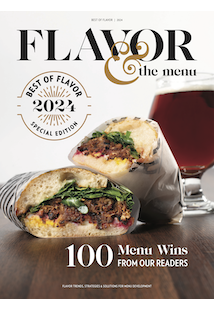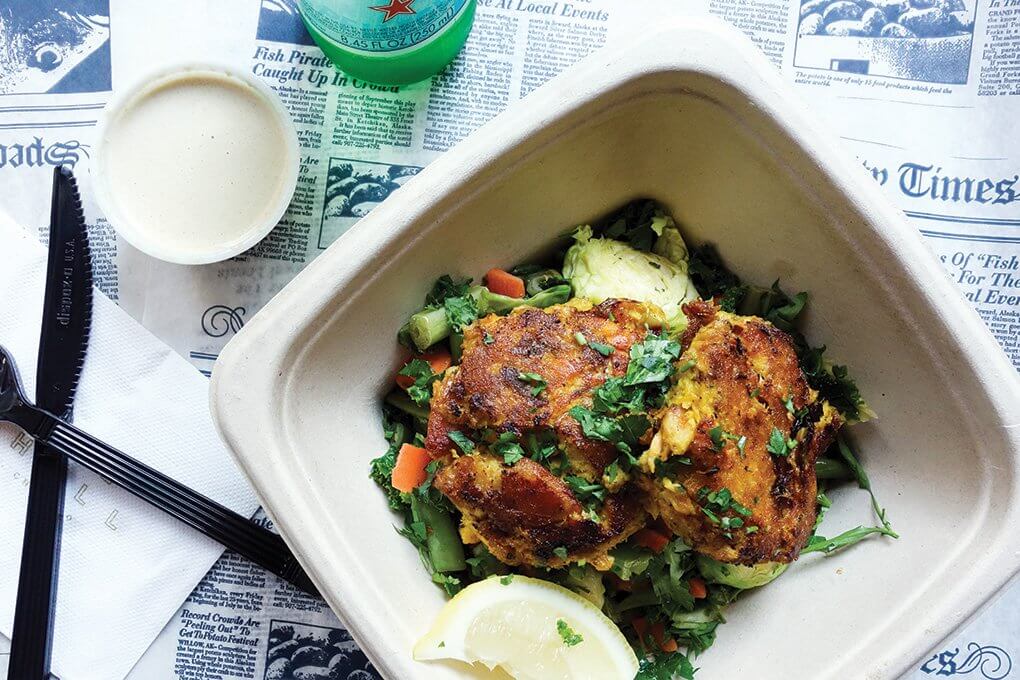It is seafood’s turn for innovation. Waiting in the wings for years, watching with impatient delight as the flavor renaissance and casualization movement made stars out of so many menu standbys, so many classics. Admittedly, there has been the occasional understudy glory, where chefs have called on fish tacos and fish and chips, giving them the spotlight and letting them perform with unexpected flavor combinations. Now, the hits keep coming.
A new breed of modern seafood restaurants have opened across the country, serving up sustainability in unassuming dishes that don’t hold back on big, bold flavors. Fish cakes are cool again, served at happy hour, maybe laced with curry and sporting a spicy dipping sauce. Poke has invaded the mainland, making marinated, raw fish a viable choice for a quick lunch on a Tuesday.
“In the better-food sector of fast casual, we’ve seen a massive expansion of better products, like burger, pizza and chicken, but nothing in seafood,” says Andrew Gruel, founder and executive chef of Slapfish, a fast-casual seafood concept with seven units in California. “Our mission was to take seafood and make it sexy.”
A number of other concepts share the same vision: Reelfish in Colorado, Snaggletooth in Chicago, Brown Bag Seafood Co. in Chicago, to name a few. Collectively, they understand the opportunity and are thriving.
They’re also pushing the trend forward, setting high consumer expectations and challenging flavor boundaries. This all makes an exciting flavor story that’s firmly anchored in modern values of sustainability and feel-good food.
 Kikkoman Sales USA, Inc.
Kikkoman Sales USA, Inc. For an on-trend take, Chef Harold Jurado of Bon Appétit Management Co. spikes tuna tartare with soy sauce, ginger, sesame oil and lime, and serves it on toast with Sriracha egg sauce and pickled onion.
The opportunity is big, answering the need for innovation across multiple menu parts. Fish tacos, sandwiches and burgers lead the charge in forward-thinking handheld ideation.
As example, look to the Shuck Shack in San Antonio. Its Spicy Banh Mi Fish Tacos star market fish, cucumber, carrot, mint, Thai basil, jalapeño, Kewpie mayonnaise, fish sauce vinaigrette and Sriracha.
Or the Ahi Tuna Burger at Hopdoddy Burger Bar with sushi-grade tuna, sprouts, teriyaki, honey wasabi, nori chips, pickled ginger and mayonnaise.
Or the Nashville Hot Fish Sandwich at Plan Check Kitchen + Bar in Santa Monica, Calif., with crisp mahi-mahi, makrut lime slaw, kombu pickles and cayenne.
Bar bites and Shareables
Restaurants looking to add dynamic bar bites and shareables can do so by tapping into this trend, from fritters and cakes to ceviches and dips.
At Root in New Orleans, a bar bite takes the shape of Pickled Shrimp & Deviled Eggs with pimentón, pommes maxim and smoked Louisiana caviar.
Cold Storage in Chicago is showcasing the trend in seafood towers, which are following the path laid out by charcuterie boards. Cold Storage also serves up a scallop and coconut ceviche, with cilantro, lime and finger chiles.
Entrées
Flavor-forward seafood entrées are supplanting the meek baked whitefish that’s cheered up only by a breadcrumb topping. Now, it might be pan-seared mahi-mahi with a lump blue crab citrus salad with oranges, cilantro, red peppers and green onion, an LTO at Houlihan’s.
Or a Powerbox, starring teriyaki-scallion salmon, quinoa and brown rice, spinach, fresh herbs and lemon, at Brown Bag Seafood Co. in Chicago.

Bright, clean flavors with just a prickle of heat are part of the new raw fish trend. At Acorn in Denver, Colo., Hamachi Crudo stars passion fruit vinaigrette, avocado, Persian cucumber and Fresno chili.
Sustainability
One of the main hooks into the seafood trend is sustainability. It lends a meaningful narrative that resonates with diners. “Many of these operators make sustainability and ethical sourcing a core component of their messaging strategy, aligning with a general consumer desire to know more about where and how their food is sourced,” says Amanda Topper, associate director of foodservice research at Mintel. Brown Bag’s messaging touts “lean and clean;” Soulfish Poke in Las Vegas claims community, health and environment; and Slapfish calls out “sustainability in practice.”
“Consumers are craving clean, healthful proteins, and chefs are excited about the creativity seafood affords them,” says Rob Corliss, chef and founder of ATE (All Things Epicurean) who also serves as executive chef at the fast casual Unforked in Overland Park, Kan. “The consumer connection to food with a story reflects the allure of seafood. From endangered species, best fishing practices, health and wellness to regional favorites, seafood can deliver a compelling and genuine story.”
Donna Lee, founder of Brown Bag Seafood Co., opened the fast casual in 2014 with a focus on providing flavorful, sustainable fresh fish. Currently with two units in Chicago, the brand is in growth mode, opening two more locations this year. “We saw a need in the fast-casual format for fresh seafood,” she says. “My goal was to create a user-friendly approach around a healthful lifestyle. I wanted to change the old-school mindset of either getting a fast-food lunch of pulverized fish sticks or a thirty-dollar grilled salmon at a white tablecloth. This is a different option.”
At Brown Bag, diners can customize their seafood experience, choosing from sandwich, salad, taco, “straight up” or Powerbox options. Protein choices include a daily catch, crispy fish bites and salmon with teriyaki scallion. Curry fish cakes are a newer item, served with a side of fresh ginger-lime sauce. “We sell out faster than we can make them,” says Lee. The most popular item, she says, is the rotating daily catch. “It gives us flexibility in offering what’s fresh, available and sustainable, and it helps us tell our story,” she says.

Grilled Oyster Co. adds signature flavor appeal to its grilled oyster flight, including toppings of barbecue sauce and chilled cucumber relish, or roasted turnips, carrots, radishes and guajillo salsa.
A nimble approach to sourcing is a component of sustainability. At Rapp Session in Richmond, Va., Dylan Fultineer, executive chef, serves an underutilized species in his bluefish dip (smoked bluefish, crème fraîche, lemon juice, Espellete, dill pickle, fresh dill). A bar snack paired with saltines, it sells for $4. “It’s our No. 1 seller, and helps us promote an underutilized species.”
Slapfish’s Gruel also employs a strategy around sustainability. “I think that our guests are choosing the dish, not the fish,” he says. “The scientific data on overfishing changes all of the time, so we use what’s sustainable that week or month, and change it when we need to. People come here for our fish tacos—not necessarily for our cod fish tacos.”
Flavor carries this trend, luring diners in with craveable, memorable combinations. “My goal is to go big, so I have to keep flavors unexpected, but approachable,” says Gruel. “Of course, we have to be mindful of cost of goods—it’s a nuanced formula.”
His strategy employs the modern-day go-to of taking classic dishes and reinterpreting them with bolder flavors. “Our lobster roll, for example: I don’t think Millennials want buttery. They want spicy, they want acidic,” he says. So he changed it up, making it a “Clobster Grinder,” with lobster, crab, red wine vinegar, chiles, chives, oregano, chipotle and fish sauce—all tucked into a Hawaiian sweet roll.
Modern flavor mash-ups underscore Plan Check’s menu, with dishes like a Korean Cioppino, with mussels, clams, calamari, shrimp, gochujang and a “soju bomb,” as well as the Lobster Pot Pie with curried lobster bisque, baby beets, green beans, corn, carrots and potatoes.
“We take care of every food detail at Plan Check, but our attitude is comfortable, not pretentious,” says Terry Heller, founder and owner. “Our strategy is based around no flavor boundaries, as long as it’s delicious and starts with high-quality seafood.”

Customizable poke bowls at Da Kikokiko in Playa Vista, Calif., showcase the giant opportunity, with numerous options, like yellowfin tuna with spicy mayo, scallion, Serrano, smelt egg, furikake and tempura crumbs.
Poke Nation
Five years ago, the notion that American consumers would stand in line for cured fish was absurd. But today they’re doing it. Born in Hawaii, proliferating through food trucks on the West Coast, and now housed in cities like Chicago and Salt Lake City, poke is having a moment.
Already, the opportunity is shifting, expanding its flavor combinations and building on the winning platform of cured fish and customizable toppings. Da Kikokiko in Playa Vista, Calif., offers signature poke bowls, including yellowfin tuna with spicy mayo, scallion, Serrano, smelt egg, furikake and tempura crumbs.
Soulfish Poke, a regional chain with three locations in Nevada, offers an array of choices, including the Zen Bowl, with cured salmon, chives, crispy onion, sesame seeds, cucumber, avocado and dill crema, served over five-grain blend or vegetables.
“We had poke on the menu five years ago, with a really nice ahi tuna,” says Keith Brunell, corporate executive chef of Nordstrom Restaurants, with 128 restaurants in the United States and Canada. “Now, we’re doing a riff on the traditional with wild salmon, jalapeño, orange, olive oil, fresh basil, served with tostadas.”
Poke is helping to energize seafood innovation. “There is a huge interest in poke. It’s like the new crudo, and the possibilities are endless,” says Kathy Casey, chef and founder of Kathy Casey Food Studios/Liquid Kitchen. “Poke is being redefined as cut-up fish or shellfish with fun things mixed in and seasoned well. We are seeing it as shareable appetizers, in grocery stores, deli cases, poke bars and as a topping for salads or bowls.”
Although somewhat overshadowed by poke’s bright star, ceviche is also seeing flavor innovation, moving beyond themed restaurants and into mainstream. Places like SuViche, with four locations in Miami, highlight the various styles of this cured-fish dish, from Peruvian-style with aji amarillo to Mexican-inflected, with onion, tomato and avocado.
Flavor-forward seafood in all forms is a sustaining trend, with reach well into the future. It pulls from so many other trends, like wholesomeness, sustainability, flavor narrative—all giving it a slipstream to glide in for a long time to come.










